Whether you’re new to curling or you’re looking to replace a trusty pair of shoes that you’ve had for years, picking just the right pair can be an intimidating process if you don’t know what to look for! Handedness? Teflon… thickness? Antislider? Toe coat?!
Fear not dear reader, we’re here to break it all down for you and make things as easy as possible. By the end of this post, we’ll have you familiar with all these terms and ready to buy some curling shoes!
In this buyers’ guide, we’ll cover:
- What is on the bottom of curling shoes?
- What kind of slider should I get?
- Right-handed, left-handed, or double gripper?
- Other slider considerations
- Curling shoes or custom shoes?
- Fit and comfort
- Toe coat
What is on the bottom of curling shoes?
The basics of a curling shoe are actually pretty simple. A pair of curling shoes consists of two different soles: a gripper and a slider. The gripper is made from a soft rubber which gives you traction on the ice, like a car’s winter tire.
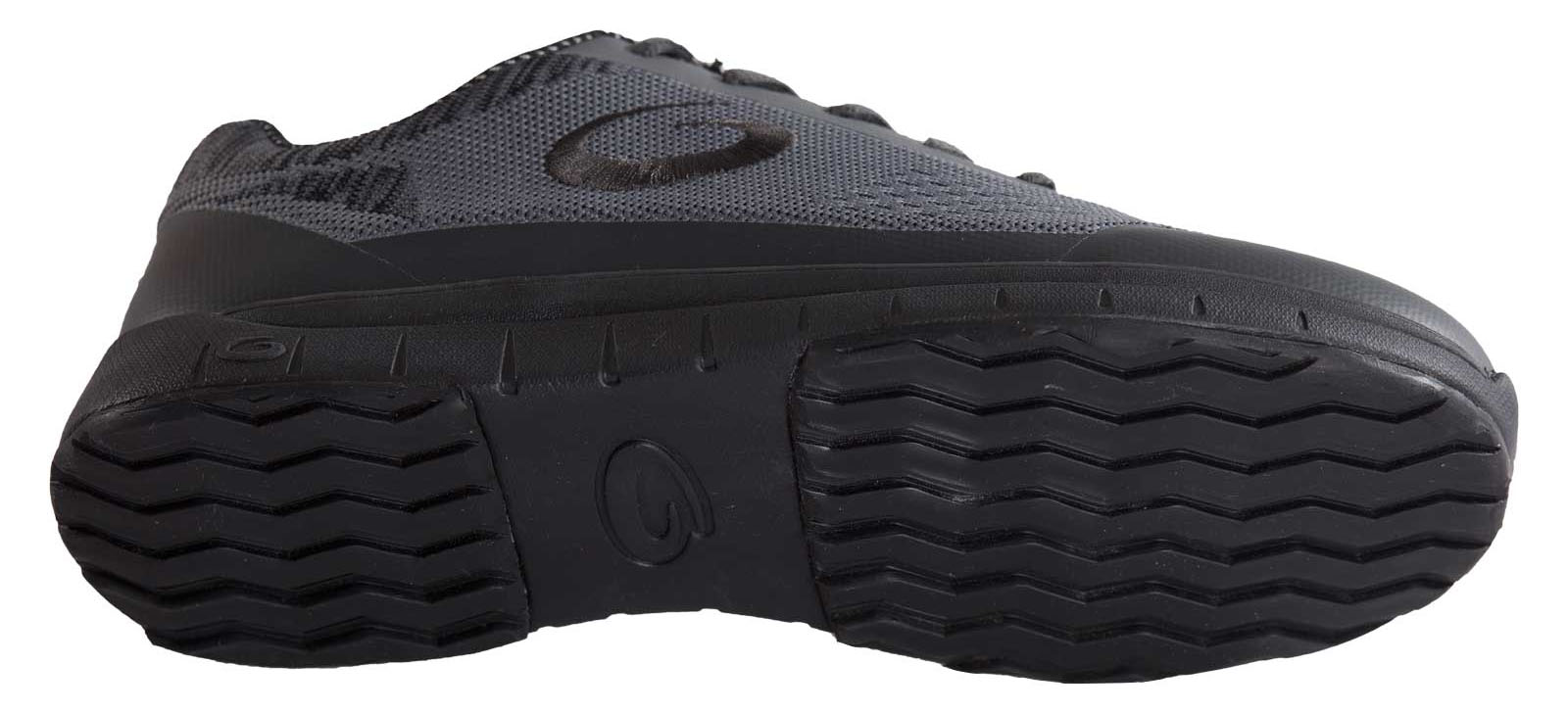
The slider can be made from a variety of products, but the most common by far is Teflon, or PTFE. Teflon is a specific brand name, PTFE is the generic name and stands for Polytetrafluoroethylene. Another material you may see commonly used is stainless steel. The reason we use these materials is they have a very low coefficient to friction, which is just a fancy way to say that they slide very well!
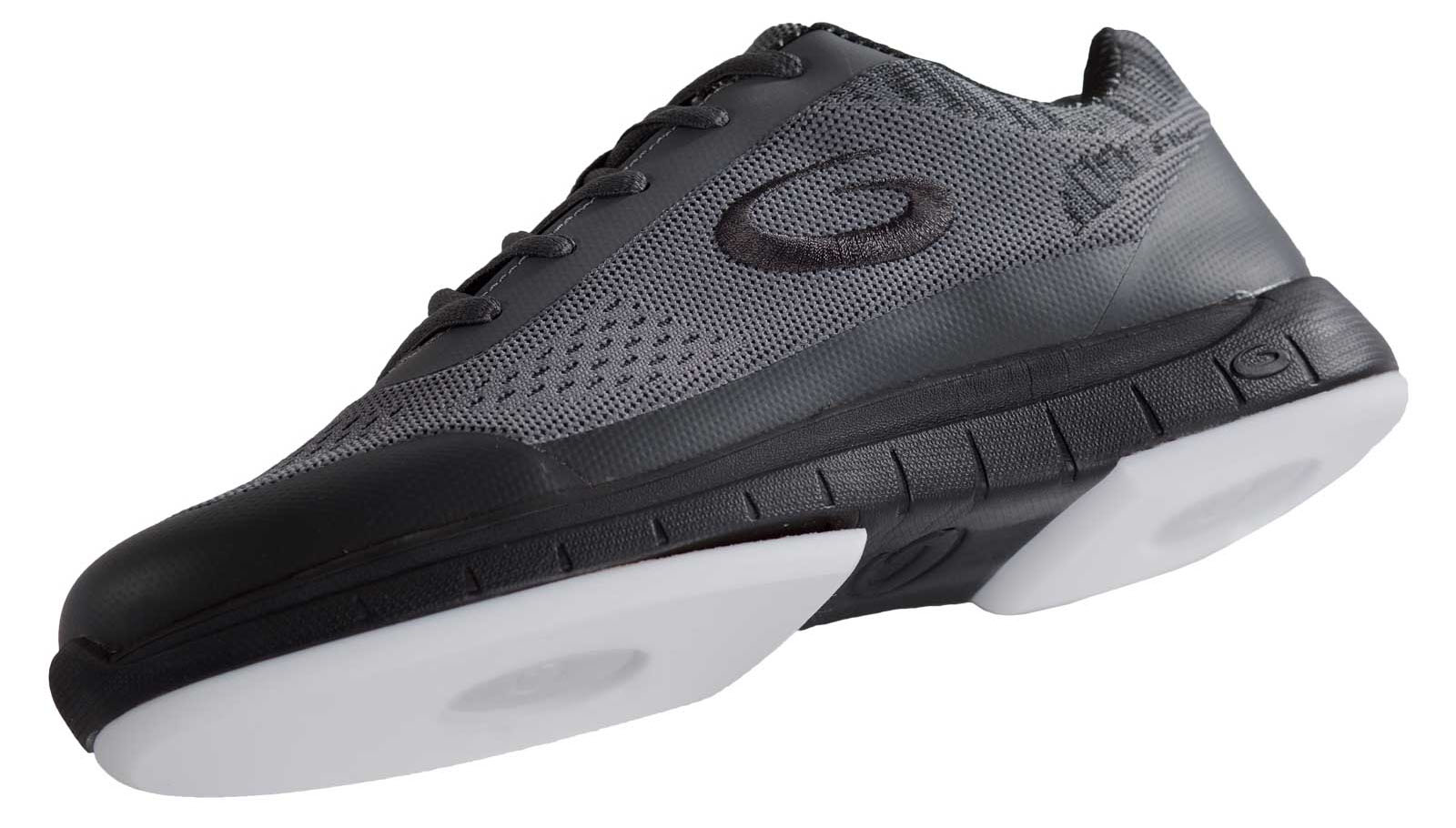
What kind of slider should I get?
This possibly the most important question when picking a new pair of curling shoes! The simplest answer is that for most people, a faster slider is going to be better for your game. When your slider is slow you will do things to compensate that will hurt your accuracy. This could be shoving yourself out of the hack as hard as you can, or dropping your shoulder to give the rock an extra shove. Whatever you do to compensate for a slow slide, it will make it much harder to be accurate!
So, what makes a slider faster?
A key feature of curling ice is how it is pebbled with little droplets of water, which is great for making a rock curl! However, PTFE is a very soft material, so when you have a thin PTFE slider it will ride up and down on these pebbles, creating more friction and resulting in a slower slide. Traditionally we have overcome this by having thicker sliders. If your slider is just PTFE, a thicker slider = a faster slider.
On a 10 point scale, where 1 is slow and 10 is fast, we would rate PTFE thickness as:
- 3/32″ = speed 5
- 5/32″ = speed 7
- 1/4″ = speed 10
Goldline Curling has introduced other methods to make sliders faster, which is why we’ve adopted this numbered scale. For example, the speed 10 discs for Quantum shoes uses a PTFE that is much thinner than 1/4″, but still slides fast thanks to the overall design of the discs. Rating sliding speed with a number makes it easier to directly compare sliders of different compositions.
The other prime example is stainless steel. We rate stainless steel sliders as a speed 12, which is currently the fastest slider available.
Right-handed, left-handed, or double gripper?
This is one that often confuses people. With all the focus on the importance of sliders, people frequently mistake “right-handed” as meaning that the slider is on the right foot, but the opposite is actually true! Check out this picture of right-handed curler, Brendan Bottcher, sliding out of the hack:
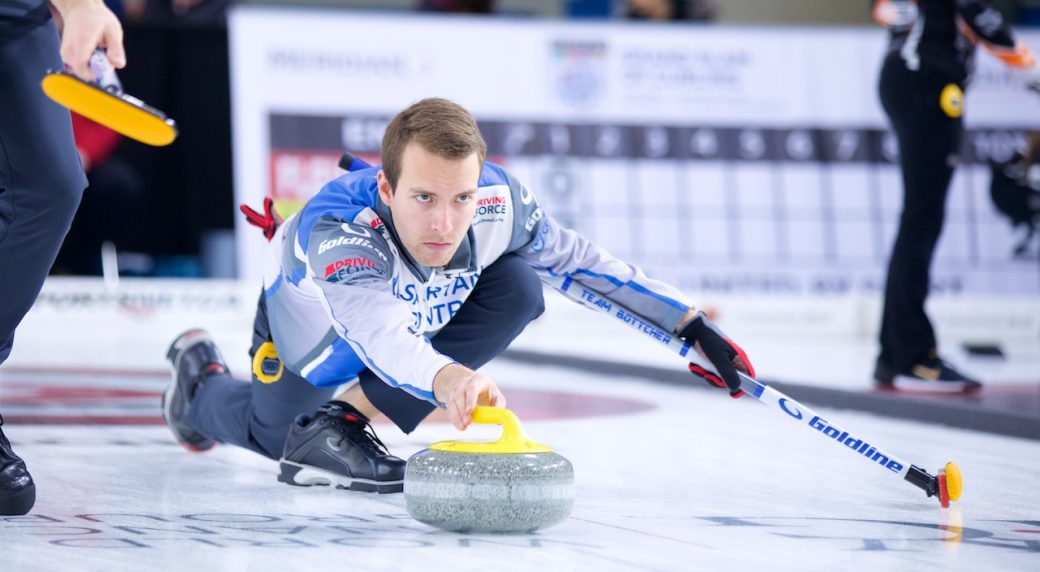
As you can see, a right-handed curler delivers the rock with their right hand and they slide on their left foot. So, right-handed shoes have a left-foot slider, and left-handed shoes have a right-foot slider. If that’s too confusing to remember, don’t even think about what’s on the feet! If you’re right-handed, get right-handed shoes. If you’re left-handed, get left-handed shoes (unless you don’t throw the rock with your dominant hand!).
Ok, but what about double grippers?
Some people don’t need to slide at all. This could include coaches, ice technicians, stick-curlers, etc. The soft tire-like rubber gripper on curling shoes provides the best traction on the ice, so a double gripper shoe has these grippers on both feet. This allows people who don’t slide at all to walk with confidence on the ice.
Other slider considerations
Have you noticed that some curling shoes have indents? The purpose behind this is to take your weight off the ball of your foot and spread it around the periphery. This helps to spread out your weight, and improve your balance. Remember, better balance = more accurate throws! A smaller surface area in contact with the ice also helps to reduce drag from friction, and therefore keep you sliding quickly.
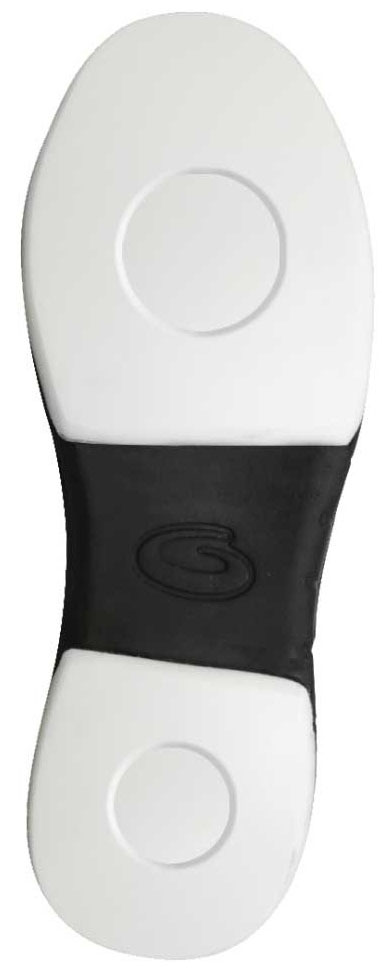
Note that with thinner sliders, such as the 3/32″ Speed 5, the PTFE is too thin for this technique, so the sliders are flat.
Goldline took this same approach when designing the Quantum shoes. The layout of the Quantum discs is not accidental but rather designed specifically to provide you with a “stability channel” down the center, helping with your balance, your ability to slide straight, and ultimately improve speed and accuracy.
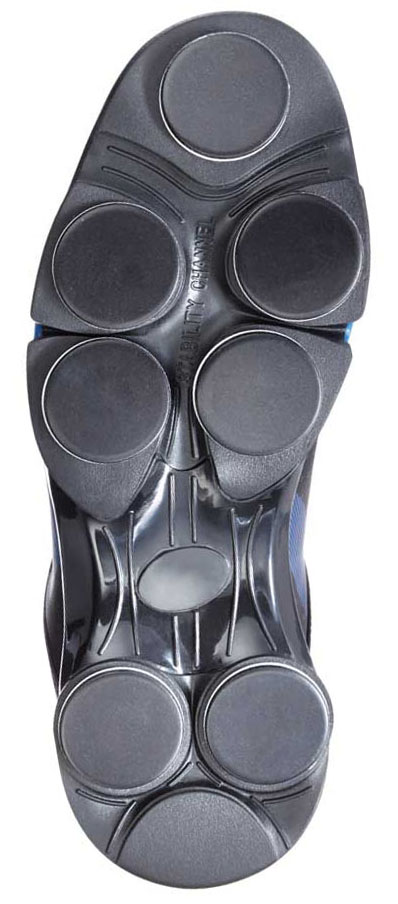
Something else you may notice about modern sliders is that they don’t usually run the full length of the shoe. This is referred to as a “split slider” and it helps improve mobility, which is especially important for when you’re walking. Imagine what it would be like to run in a pair of shoes with plywood attached to the soles! That stiff, awkwardness is what we’re trying to avoid by implementing a split slider.
This is also why most shoes have a “hinged” slider. Only about 70% of the toe section of a hinged slider is attached to the shoe. This is not a manufacturing defect but rather is done on purpose to give additional flexibility.
Hinged, split sliders are especially important for anyone who slides up on their toe, instead of keeping their foot flat on the ice. This technique is frequently referred to as the Manitoba Tuck, and can been seen on almost all top Manitoba curlers, like in this picture of Jason Gunnlaugson, since you need a very flexible shoe to slide like this!
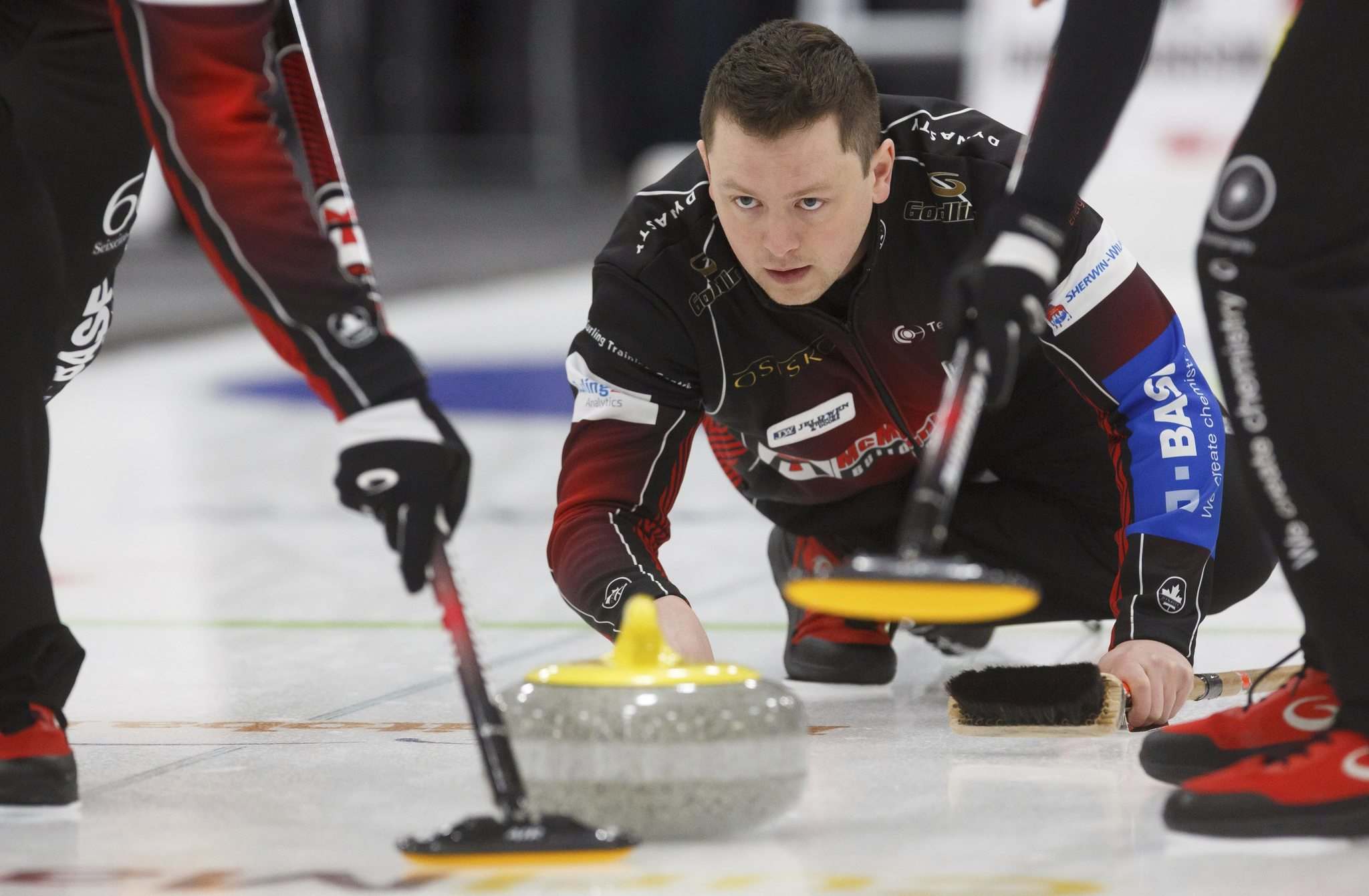
Curling shoes or custom shoes?
One of the trends that we’ve seen in recent years is more and more people having custom curling shoes made, rather than buying purpose-built curling shoes. At Goldline, we definitely get the appeal, and we even have a workshop at our primary office dedicated to making custom curling shoes!
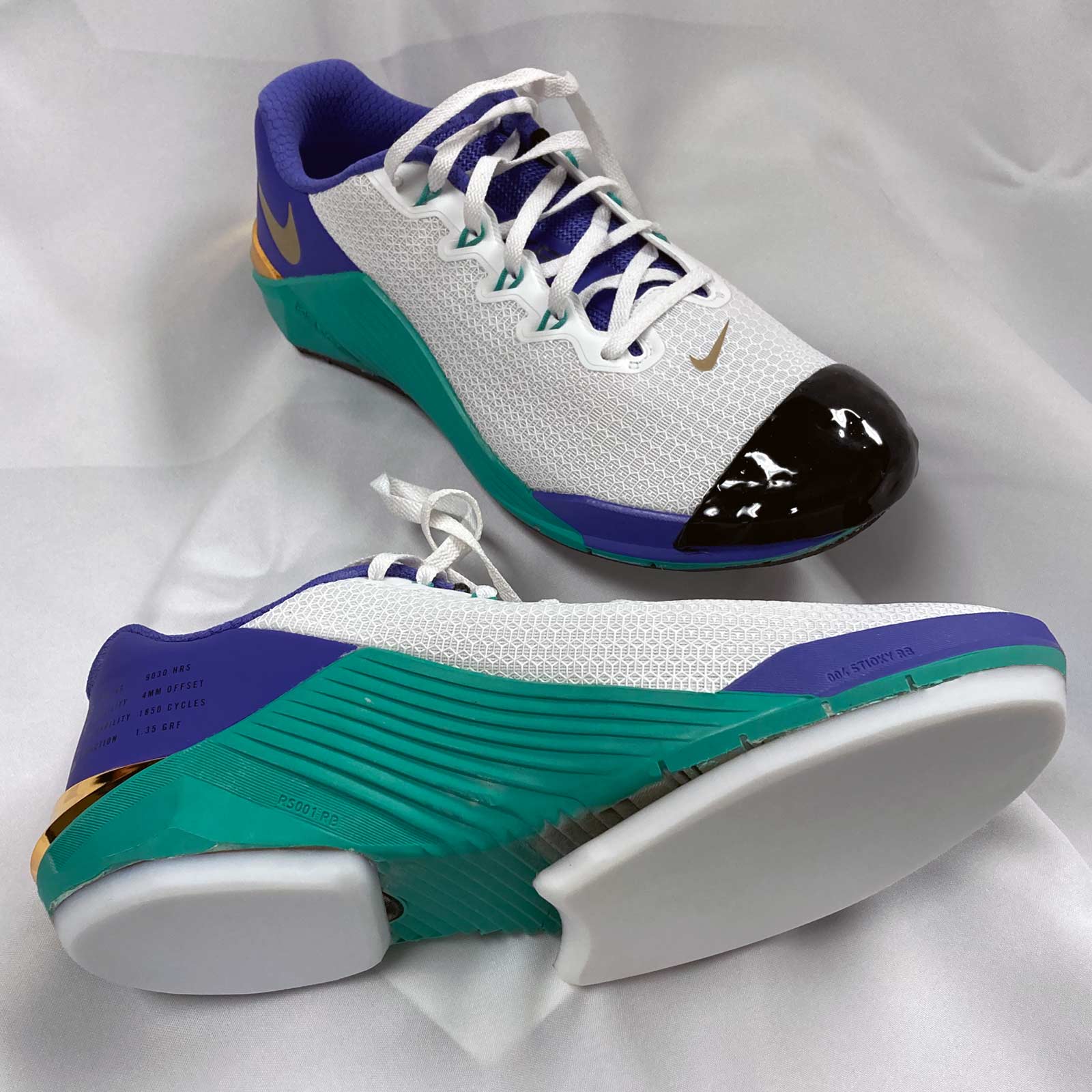
Before you send in your favourite runners for conversion, there are a few pros and cons that you should consider.
Insulation
Did you know that Goldline curling shoes all have insulation in them? Obviously, curling takes place on ice, ice is cold, and most people don’t like cold feet! So, we insulate all of our shoes. This may not be so important to the high-performance athletes you see on TV, because the lights and audience all create a warmer than normal curling atmosphere. The typical curling club can definitely get chilly though, so if your feet tend to get cold, you may want to stick with curling shoes instead of getting something custom.
Toe box
One of the surprising things about curlers is that they all claim they don’t kick rocks. Head out to your local club though, and you’ll see almost everyone doing it! There’s no need to deny it or be embarrassed, it’s just a part of curling. However, you should know that in the battle between your toe and a 19 kg curling rock, your toe might lose. To protect against this, all Goldline curling shoes have a hard toe box to provide protection when you’re kicking rocks. If you go with a custom shoe, take care when it’s time to collect rocks when the end is over.
Lateral stability
As we’ve already discussed, stability is important for shot accuracy. If you’re wobbling around while you slide out of the hack, you’ll never throw an accurate rock. So, while a good curling shoe has the flexibility for you to walk comfortably or get up into your Manitoba Tuck, you don’t want it to rotate down the middle. We refer to this as lateral stability.
Not only is this important for shot accuracy, but it is also a safety consideration. If your shoe doesn’t have enough lateral stability you run the risk of rolling your ankle during delivery and injuring yourself.
For this reason, weight lifting shoes such as the Nike Metcon have become very popular for customization.
Fit and comfort
A curling shoe should provide an athletic and supportive fit to help players maintain their balance and form while sliding or sweeping. It is important to ensure a snug fit, to prevent the foot from slipping in the shoe at the heel and causing blisters, especially from the force of pushing out of the hack. A curling shoe should generally fit like a running shoe, so that is a helpful guideline when thinking about curling shoes and the fit you are looking for and also to have a reference to select a size as your favourite running shoe size is likely a good baseline to find your correct size in curling shoes.
Toe coat
The purpose of a toe coat, sometimes called a toe-dip, is twofold: protect the toe of the dragging foot from abrasion from the pebble; and, provide a surface on the dragging toe that is faster than the shoe itself.
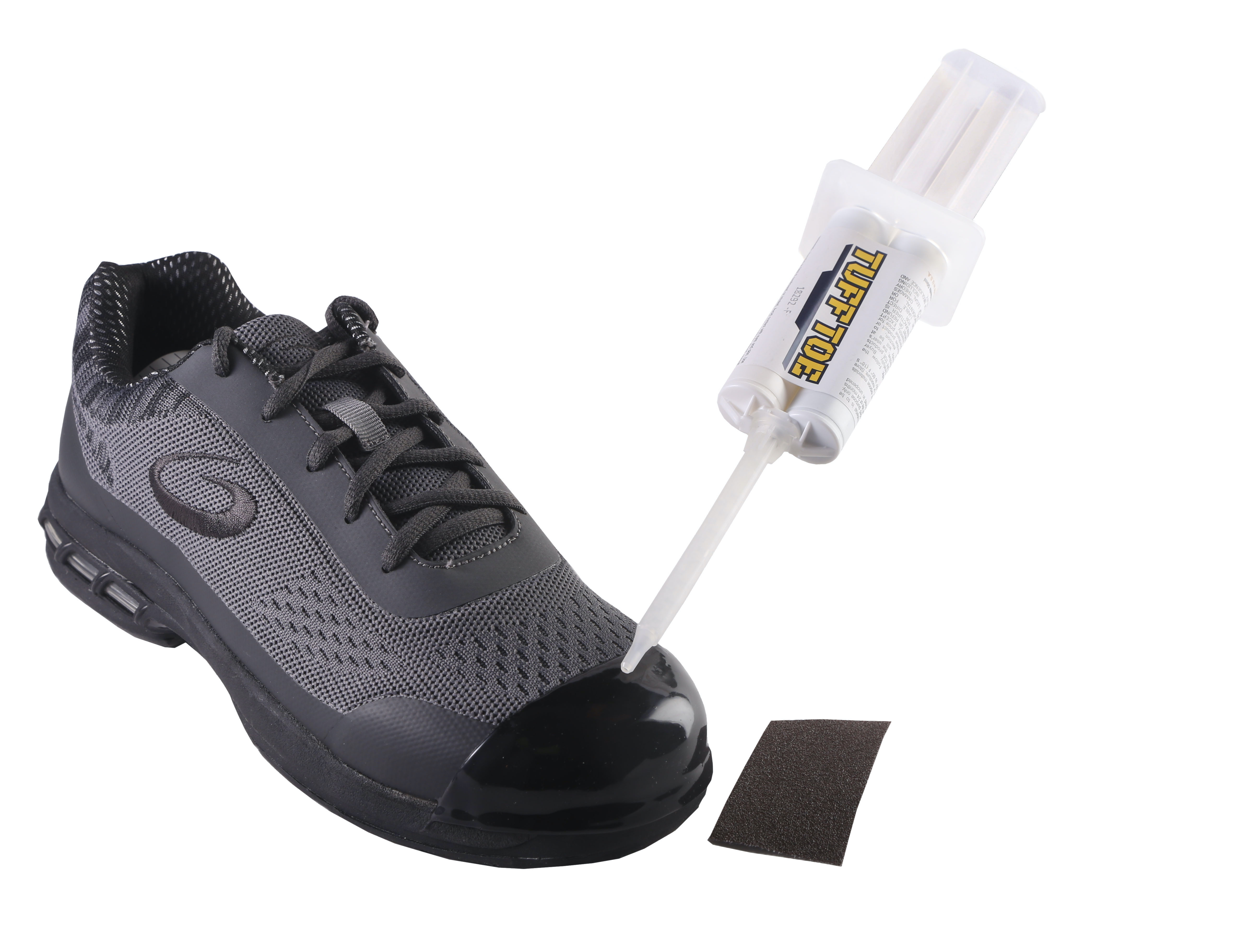
Any questions?
Did we answer all your questions about curling shoes? If not, let us know in the comments or contact us at store@goldlinecurling.com. We’re always happy to help!

Do you sell stick curling brooms with telescopic on one end and brush pad on other end
Hi Thea, we do not have any more Flip Duo’s in stock. I’d suggest taking a look at the Saber as an alternative.
Interested in the fairly new soft shoe with double grippers as I am a stick curler and also womens finese curling pants. Can you let me know cost of each. Thank you
Hi Sylvia, the Swagger are our current double gripper shoes and they sell for $149.99 CAD / $139.99 USD, and the Finesse pants are $109.99 CAD / $99.99 USD. These prices are accurate as of Dec 2, 2022.
My 1/4″ podium Gold shoes feel faster then my 1/4 G50’s. Is that possible?
Hey Darcy, there are two things that could be going on here. First, PTFE (aka Teflon) can take some time to break in. Are your G50s brand new? If so, you may want to give them a few games and see if they come up to speed. The second issue is which G50s are you using? We upgraded the PTFE that we are using when we moved from Velocity to Cyclone, which is why they have different speed ratings (Speed 10 vs Speed 11).
My daughter (12) is almost finished her first season of curling. If I were to purchase curling shoes for her, what speed is recommended? She still has a bit of a wobbly slide, but improves all the time. She’s also right handed but curls left handed. Would I go with the slowest slide or mid range?
Hey Michelle!
I would recommend going with the new Momentum series shoes. They were introduced after I wrote this blog post, so you don’t see them featured here (I will update things soon!).
The Momentum series would be a great fit for your daughter because the slider and gripper are attached by velcro. In your situation this provides multiple benefits. I always recommend starting with the fastest slider that fits your budget, but if you decided you wanted to start with something slower you can easily upgrade when your daughter is ready. You could, for example, buy Speed 8 discs now, and then upgrade to Speed 11 discs when she’s ready for more speed.
Also, with her unique right-handed / left-handed situation, these shoes are ideal. You can configure them for left handed play now, and if she ever decides that she would rather be throwing right-handed, you can simply swap which foot the slider and gripper are on.
Finally, with her only being 12 years old, her feet could still be growing. If she outgrows the shoes within a year or so, you can likely just buy new shoes and move the discs from her old shoes over to the new ones, making a sizing upgrade less expensive. You can see the Women’s Momentum Rush Shoes on our site today, and we’ll have new styles arriving over the summer for next season.
Thank you so much for the info!!
You’re welcome!
I was just thinking about your original question, and believe it could be beneficial to provide a little more context around my answer. A faster slider is almost always a benefit to a curler’s performance. In your daughters example, her wobbly slide could be caused, in part, by pushing too hard out of the hack to compensate for slower shoes. There are multiple things that people do subconsciously to compensate for slow sliders, whether it’s pushing out of the hack so hard they aren’t in complete control, or dropping their shoulder to get more power and therefore compromising their alignment, or, commonly, shoving the rock towards the end of their slide, which will impact the rock’s slide path and curl.
This is why I always say to go with the fastest slider that fits your budget. Barring any specific circumstances where a curler really prefers a slower shoe, a faster slider is almost always better for your game.
Hi…one more question…
She wears a women’s 9.5 running shoe. Does that mean I get her a 9.5 or 10 curling? Or a
6 or 7? I’m looking at sizing and getting confused lol. Thanks for your help.
If we measured correctly, her foot is 9.5” long
Hi Michelle, I have someone on my customer service team reaching out to you to help you pick the correct size. Look for an email from store@goldlinecurling.com.
Do you have a chart that shows length and width of feet and provides the shoe size needed I’m looking for new ladies curling shoes but have a wide foot.
Hi Margo, one of the images on each of our current shoes on our website shows the measurements. I hope this helps!
Which is the best type of slider for someone who does the Manitoba Tuck?
Hi Allison,
Most of our current shoes would work, you just need to avoid the introductory level shoes, such as the Chinook. The thinner sliders on those shoes are full attached. Once you get up to the Storm, Cyclone or Momentum Rush, these shoes all have split sliders. This means that the front slider is only partially attached, which gives you enough flexibility to get right up on your toe.
Next season we will also be introducing three new Momentum styles, Dash, Charge, and Dart, which will also have this same style of slider.
Do you have an extra wide 4e stick curling shoe?
Which model of shoe is a direct replacement for the podium gold?
Hi Ken! I suppose that depends on what you mean by “direct replacement.” We retired the Podium outsole and improved upon it with the new Momentum series. The first shoe in that series is our Momentum Rush, which we launched this season (2022-23). We are coming out with three new shoes on the Momentum platform next season (2023-24), which will use the Momentum outsole along with a new upper design, which also features a lace cover. If you’re looking for something that is an upgrade from the Podium series, I think this will be your best way to go. Momentum Rush is available now, and we’ll be launching Dash, Dart & Charge in late spring / early summer 2023.
Hello, does the shoe base matter if i were to send to you for custom slider/gripper? i have a good pair of trail running shows but the tread isnt that flat on the bottom for mounting, is there a guideline? thanks
Hi Zach, yes, the sole of the shoe definitely matters. You will get better results with a shoe that has a relatively flat sole, both in terms of the curve of the sole and any patterns in the sole’s material. Shoe customizers can compensate for these features, but the results will be better if you stay within these guidelines. In recent years we’ve seen a lot of Nike Metcons being customized because they have these preferable features, plus they have good lateral support.
What can you purchase if you wear a EEE wide foot. Doesn’t seem to be any shoes that cater to a wide mens foot.
We’ve had individuals visit us to test out our new Momentum shoes in EEE sizes, and they’ve found them to be a comfortable fit. If you happen to be near one of our stores, we welcome you to drop in and experience them for yourself.
I’m an 80 year old agiile curler. Would the cyclone slider be suitable for me..
Hey Charlie! If you’re still able to get down in the hack, the Cyclone would be a great shoe for you!